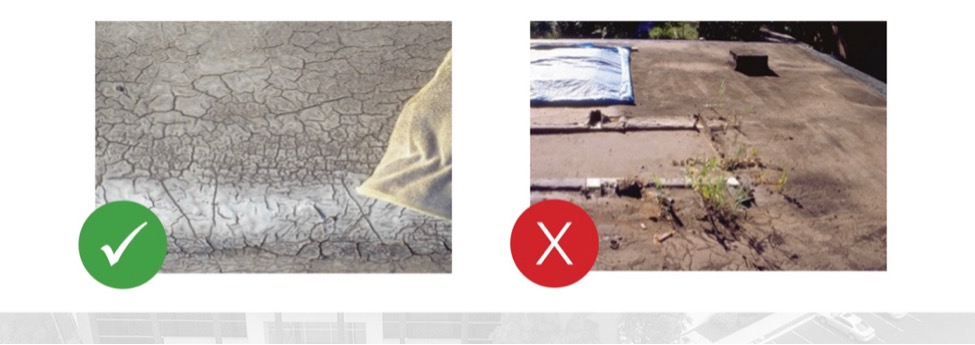Recognizing the Opportunities for Restoration
Analyzing

Roofs with low to moderate damage or good candidates for restoration, but a reroof will be required when roofs are extremely damaged.
With your roof inspection complete, it’s time to determine a path forward. Roofs with low to moderate damage and saturation levels are often good candidates for roof restoration rather than a full recover, and they can be a cost-effective option when the circumstances call for it. Reroofs will be required in more extreme scenarios, with elevated levels of insulation saturation, decking deterioration, and more. As stated before, a good rule of thumb is that any roof that is more than 20 percent saturated is deemed a full tear-off, per many national building codes and standards.
In addition to the level of damage uncovered during inspection, there are some additional considerations that should be made when determining the right repair technique for your project. Some of these include:
What is the anticipated lifespan of the building? Not every structure merits the same level of repair work. A small retail store that sits in the path of a proposed freeway expansion, for example, might not need a repair that ensures 20 years of performance. A major museum in the hub of a cultural district, by contrast, will require a long-term solution. In either case, proven repair solutions are available to best suit the needs of the given situation.
Are there plans to expand the building in the near future? It’s generally more economical to reroof a structure in conjunction with an expansion rather than split the project across multiple years. The need for roof access and impact to building operations can be greatly reduced if both projects can be performed at the same time.
Where and at what time of year will the work be done? A 30-story condo tower in Florida has very different wind, thermal shock, thermal bridging, and UV exposure than a single-story industrial plant in the Midwest. These types of conditions should be considered when developing a repair or replacement plan.
What is the building use and type? Different types of buildings serve various functions and have specific requirements for their roofing systems. For example, a commercial office building may have different needs than a residential home or an industrial facility. Building codes and regulations also vary depending on the building type and use, as well as aesthetic considerations. A hospital and operating room may look completely different from a restoration over the top of a warehouse that houses empty paint cans, for example. And the type and use of the building can influence the budgetary considerations when deciding whether to repair, renovate, recover, or reroof the roofing system.
The Case for Restoration

A 30-story condo tower in Florida would require a different roofing approach than a single-story industrial plant in the Midwest.
Your determination of the right repair method will depend on the specific circumstances of the job at hand. In situations where restoration is appropriate, you’ll find some significant advantages versus reroofing or other alternative repair measures.
Restoration generally requires far less specialized equipment and does not leave the building interior exposed while the job takes place. A good roof restoration process involves removing any debris and cleaning the roof to prepare for the rest of the project. Next, depending on the condition of the roof, a primer is applied to ensure good adhesion for patching, stain blocking, and rust inhibition. Then, patching is performed to make sure all parts of the roof system are watertight. Finally, protective coatings can be applied to ensure long-lasting performance. All the while, regular activity inside the building can continue uninterrupted.
Restoration jobs can also happen far faster than an entire reroof. For contractors, time is money. If you can successfully bring an existing roof back up to its original performance level with restoration methods, you can move on to your next job more quickly. A restoration project can be undertaken with the purchase of just a few high-performance products, a far more cost-effective solution than replacing the roof entirely. Full restorations on average range between $400- to $700-per-square, while tear-off and replacement starts at $1,000-per-square and can go up from there depending on region and project complexity.
For a restoration project to meet its full potential, you can also work with the trusted supplier of high-performance coatings and mastics to help ensure a job well done. Modern mastic formulations are able to deliver outstanding performance that building owners can rely on for the long term. The right supplier may also be able to help you ensure best practices are followed on your next job, leading to more satisfied customers.
Section 3: Common Restoration Practices

With metal roofs, it is important to focus on seams, fasteners, and penetrations during the renovation process.
Adhering to best practices is of utmost importance when undertaking a roof renovation. These practices ensure that the renovation project is executed with precision, quality, and safety, leading to a successful outcome. Following best practices, such as conducting a thorough inspection, testing, selecting appropriate materials, and addressing underlying issues, helps mitigate potential problems and ensures that the renovated roof performs optimally for years to come. Best practices promote compliance with local building codes and regulations, ensuring that the renovation meets the necessary standards.
Metal Roofing Restoration
When it comes to restoring metal roofing, it is important to focus on seams, fasteners, and penetrations. Seams are important to protect against wind-driven rain, and if there is a poor seal or improper install, water intrusion becomes an issue. There are many theories on how to treat horizontal and vertical seams, including taping seams, lifting panels, and sealing underneath or brushing adhesive over the top. Every manufacturer has their own recommendation for both horizontal and vertical seams that should be followed.
During the restoration process look for loose fasteners, which should be removed and replaced with new fasteners. The new fasteners should be one size larger than the original one and attached with a new screw. Once the new fastener is in, apply a layer of mastic over the top of it and a secondary sealant on top of the mastic.
Next, address all penetrations, such as skylights, curbs, roof fence, and plumbing vents. If penetrations show signs of damage, such as rust, corrosion, leaks, or compromised seals, contractors should undertake the necessary repairs or consider replacing the damaged components. This may involve fixing or replacing flashing, gaskets, or seals around the penetrations to ensure watertightness and proper integration with the restored roof system. Contractors should ensure that flashing materials are correctly installed and integrated with the metal roofing system to prevent water infiltration and provide long-term protection.
Contractors may need to apply appropriate sealants or caulking around penetrations as part of the restoration process. This helps reinforce the waterproofing and weatherproofing capabilities of the penetrations and ensures a secure bond between the roofing materials and the penetrations. In general, they should ensure that any repair materials, sealants, or coatings used for penetrations are compatible with the specific metal roofing system and the materials surrounding the penetrations, especially because metal roofs expand and contract.
Single-Ply Restoration

With single-ply, it is important to look at tie-ins where the membrane transitions to other roofing components.
Single-ply roofing is a welded system—either heat or chemically welded—and for this reason, seams must be addressed. Self-adhered tape is one way to restore single-ply roofing, but as always, pay attention to what the manufacturer suggests.
With single-ply restoration it is also important to look at tie-ins where the membrane transitions to other roofing components. Flashing tie-ins, penetration tie-ins, edge tie-ins, roof-to-wall tie-ins, and expansion joint tie-ins are all critical to preventing water intrusion. Look for any issues around curves and the inside or outside corners. Other common problems seen with single-ply membranes include splits and burns, as well as repair issues with base flashings, curbs, and corners. Restoration for single-ply membrane systems typically requires adhesive repair tape or other minor reinforcement approaches.
Single-ply membranes are often exposed to UV radiation. Contractors may select coatings or treatments that enhance UV resistance and protect the membrane from UV degradation and premature aging.









